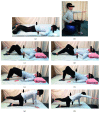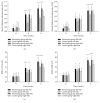Effect of Core Stability Training Monitored by Rehabilitative Ultrasound Image and Surface Electromyogram in Local Core Muscles of Healthy People
- PMID: 31341523
- PMCID: PMC6612403
- DOI: 10.1155/2019/9130959
Effect of Core Stability Training Monitored by Rehabilitative Ultrasound Image and Surface Electromyogram in Local Core Muscles of Healthy People
Abstract
Background: The purpose of this study is to investigate the influence of transverses abdominis and lumbar multifidus thickness activation and electromyogram signal characteristics after core stability training monitored by rehabilitative ultrasound imaging and surface electromyogram.
Methods: 60 healthy volunteers were allocated randomly into two groups, one of which received monitoring training and the other participated identical training without monitoring. Ultrasound image and surface electromyogram signal were collected at 0, 4, and 8 weeks during training. The muscle thickness activation ratio value and integrated electromyogram value were then extracted. During the training, the monitoring group was monitored by real-time rehabilitative ultrasound imaging and surface electromyogram while the control group was not.
Results: There are no differences in performance of local core muscles between both groups before training (p > 0.05). Compared with the control group, the thickness contraction ratio value and integrated electromyogram value of core muscles in the monitoring group were higher after 8 weeks' training (p < 0.05).
Conclusion: Together, the core stability training monitored by rehabilitative ultrasound imaging and surface electromyogram can markedly activate and enhance local core muscles in healthy people, providing a potential strategy to treat low back pain more effectively.
Figures


References
Publication types
MeSH terms
Associated data
LinkOut - more resources
Full Text Sources

